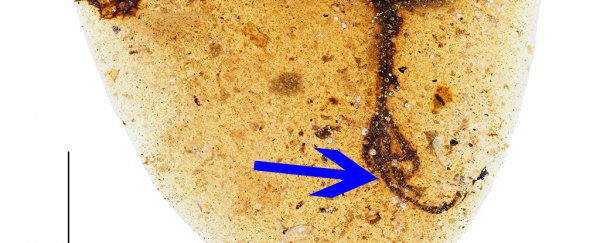A weird-looking foot preserved in 99 million-year-old Burmese amber has revealed a new species of ancient bird with one insanely long middle toe.
The newly-named Elektorornis chenguangi is a small bird distinct from all others, either extinct or living - simply because of its hindlimb. The third digit on its foot, researchers say, is twice the size of its lower leg.
"I was very surprised when I saw the amber," says palaeontologist Lida Xing from the China University of Geosciences in Beijing.
"It shows that ancient birds were way more diverse than we thought. They had evolved many different features to adapt to their environments."

Discovered in 2014 by a local amber trader in the Hukawng Valley of Myanmar, the origins of this unusual foot remained a mystery until it fell into the hands of palaeontologists.
"Some traders thought it's a lizard foot, because lizards tend to have long toes," says Xing, who was contacted about the specimen by a private museum curator.
"Although I've never seen a bird claw that looks like this before, I know it's a bird. Like most birds, this foot has four toes, while lizards have five."
The unusual toe, which is 9.8-millimetres-long, is thought to have belonged to a small arboreal bird - smaller than a sparrow - that probably went extinct along with the dinosaurs, some 66 million years ago. Today, there is nothing else quite like it.

Scanning the amber with micro-CT and reconstructing the ancient foot, the researchers found that the bird's third toe was 41 percent longer than its second toe and 20 percent longer than the bone in its lower leg.
Comparing these ratios to 20 extinct birds and 62 living birds, the authors found zero matches.
What's even stranger, these proportions are not found in any other living animal. While some arboreal creatures also have elongated third digits, which they use to grip branches and grasp onto surfaces better, the authors couldn't find any other creatures with such extreme toes.
 (Lida Xing)
(Lida Xing)
The only known animal with disproportionally long digits, in fact, is the aye-aye, a lemur that uses its fingers not so much for balance, but for foraging in hard-to-reach places, like tree trunks that house juicy larvae and insects.
In the absence of any other mega-long toes, the authors admit they cannot be sure what role this appendage played, only that it was probably advantageous in some ecological niche that's no longer exploited.
"It could represent a feeding specialisation, similar to the [Madagascar] aye-aye, or it may have facilitated greater arboreal function, or both," write the authors.
"Similarly elongated toes are also observed in some tree-climbing lizards, supporting an arboreal function for this unusual feature in Elektorornis."
The soft tissue, found on the bird's foot, is also without parallel. The filamentous structures have curious distributions and sizes that the researchers couldn't match to any other modern examples.
Yet because these structures are much longer and more robust at the base of the big toe, the authors think they might represent sensitive hairs, capable of feeling out potential food.
"Tactile bristles on the feet in Elektorornis may have aided in prey detection, together with the elongated third digit producing a unique foraging structure," the authors conclude.
For now these ideas are just speculative, but the intriguing finding is a beautiful addition to the marvels we keep finding in ancient amber.
The research was published in Current Biology.
